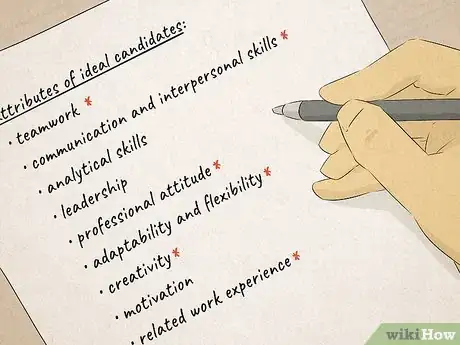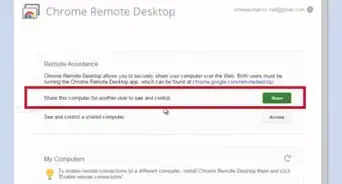This article was co-authored by Harish Chandran, PhD and by wikiHow staff writer, Jennifer Mueller, JD. Harish Chandran is the Engineering Site Lead and Senior Staff Research Engineer at DeepMind, where he leads the engineering efforts to integrate AI research results into Google products. Harish received his PhD in Computer Science from Duke University in 2012. While in graduate school, he worked as a Teaching Assistant, helping undergraduate students learn about algorithms and data structures. He has experience in DNA self-assembly, evolutionary algorithms, computational neuroscience, complexity theory, computer architecture, and super-computing.
There are 10 references cited in this article, which can be found at the bottom of the page.
This article has been viewed 5,482 times.
Whether you're launching a start-up or expanding an existing small business, building a cohesive team of employees who will work together to advance your vision is crucial to your ultimate success. It can be challenging to start from zero, but use it to your advantage! You have the opportunity to pull together an amazing group of people who will work together from day one to help your business take off.[1]
Steps
Recruit
-
1List the attributes of your ideal candidates. A strong team has members with different strengths and weaknesses who can work together to achieve your business's goals. In addition to specific education and experience requirements for each role, list some personality attributes that your ideal candidates would have.[2]
- For example, you might want team members who have an entrepreneurial spirit and are willing to take risks. This personality type can be especially valuable in a start-up.
- If you're hiring remote team members, you probably want people who are highly self-motivated and thrive in an environment with less supervision.
-
2Look for people aligned with your mission and passions. While skills are important, people who share your overall mission for your product or brand will be more enthusiastic team members. Posting employment listings on general online job boards is fine, but in addition, it's a good idea to reach out to groups or organizations where there are likely to be people who hold the same values you're trying to promote with your business.[3]
- For example, if you're producing organic vegan nutrition drinks, you might recruit team members at a local co-op or with local vegan groups on social media.
- Look beyond your business's mission and consider people aligned with your personal values as well. Productive, enthusiastic team members are often people who like you as a person and have things in common with you.
Advertisement -
3Bring on one team member at a time. Think about who you need to hire first and work to get that person in place, then move on to the next person on your list. That way, you can focus all of your efforts on finding the best person for each role.[4]
- Depending on your overall structure, you might also consider getting your first team members in on the selection process. This can help you ensure that everyone works well together. It also empowers your employees if they believe they have a say in who they work with.
-
4Include remote workers in your hiring search. During the COVID-19 pandemic, many business owners learned that employees could be productive when working from home. Allowing for remote workers means you don't have to restrict your hiring search to locals.[5]
- With some business models, you might not think remote workers would work for you. But even if you have a brick-and-mortar retail store, you could easily have a remote team member work on your website or social media presence, for example.
Onboard
-
1Host a kick-off event to stoke enthusiasm and build momentum. Getting your entire team together, either physically or virtually, allows everyone to get to know each other and get a sense of how they're going to work together. Have fun, but also take this opportunity to reinforce your mission and outline how the team is going to work together.[6]
- If your team is local, an activity that requires working as a team is a good way to break the ice and get everyone used to working together. For example, you might go to an escape room or organize a treasure hunt around your city.
- Remote teams can also participate in virtual games and puzzles that encourage team building and help your team members get to know each other.
-
2Define your mission and core values clearly. Make sure all of your team members understand why they're there and what you're trying to achieve with your business. Discuss the mission with your team and get input from each member on what it means to them.[7]
- Encourage each team member to define what they bring to the table and how they'll personally help the team achieve its goals.
- You can have a starter curriculum for the newcomers. It can include things they need to read and the exercises they need to do to catch up with the team.[8]
- Plan the processes so that the new people have a month for onboarding and ramping up. [9]
- Let each new person have one senior person who can help them in the initial stages.[10]
-
3Outline the team's goals and measurements of progress. Set goals that are specific, measurable, achievable, realistic, and timely (SMART). For each goal, establish benchmarks that will indicate progress towards the ultimate goal.[11]
- Depending on the size of your team, you might have individual team members in charge of ensuring different goals are met. Make sure each team member understands their role in achieving each goal and what you expect from them.
-
4Assign specific responsibilities to each team member. Lay out responsibilities transparently so every team member knows what's expected of every other team member. This encourages your team members to be mutually accountable to each other.[12]
- Depending on the size of your team, you might designate specific team leaders who are responsible for coordinating efforts toward particular goals, or you might simply be the team leader yourself.
- If different parts of your team are working toward different parts of the big picture, identify specific team members who will be in charge of integrating the results when the time comes.
-
5Set ground rules to govern how team members will work together. Your ground rules can be as simple as "respect each other" or "share ideas with the team," but they should be specific enough that everyone can understand and follow them. Include rules for communication, both in and out of meetings, as well as guidelines for resolving conflicts.[13]
- For example, you might promote email for routine communication, then have a text or instant messaging app available for urgent messages.
-
6Cross-train team members in several different areas. Flexible team members can pitch in and help if there's an issue in an area that's technically outside their sphere of duties. You increase the value of your team members and empower them to do what's necessary to achieve your business's goals.[14]
- For example, if you have a content writer who's interested in web design, you might have them shadow your web designer or take a class so they can learn the basics.
- Encourage your team members to share their work processes and ideas with each other so they can better understand all the different roles and how they work together.
-
7Include a trial period after initial training. For longer-term projects, a trial period allows you to make sure each team member is going to be a great fit. It also takes the pressure off of your team members because they have the opportunity to back out if they have second thoughts.[15]
- Another idea is to start team members out as contractors, then hire them on as full employees after that. It gives you a chance to audition them and see how they work with other members of the team.
Lead
-
1Create opportunities for team members to learn and grow. This can be as simple as buying books or access to learning websites that help your team members advance their knowledge. If there are various certifications that might help team members, you might offer to pay for the certification process.[16]
- Providing these opportunities shows your team members that you're investing in them and you want them to enhance their value while they're working for you.
-
2Arrange fun activities to encourage camaraderie and team spirit. Use group activities to celebrate achievements and boost morale when you're facing challenges. Even something as simple as a picnic and hiking in a park can help bring your team closer together.[17]
- You can also use these activities as rewards for reaching milestones or achieving various goals. It shows you appreciate your team members as people and value the work they do.
-
3Facilitate communication among team members. Provide contact information for all of your team members so they can all reach out to each other at any time. If one team member is having a hard time communicating with another, you might meet with the two of them to help make things run more smoothly.[18]
- Provide multiple communication options to make sure all team members are able to communicate effectively. For example, some team members might be more comfortable with email while others prefer a phone call or face-to-face interaction.[19]
-
4Check in with remote team members daily. Schedule daily check-ins so your remote members feel like a regular part of what you're doing. Ask about their progress and their plans for the day, then let them know what you and the rest of the team are doing. You might do one-on-ones or a single group meeting if you have multiple remote team members.[20]
- These check-ins help your remote team members establish a routine and understand what's expected of them on a daily basis. You also ensure accountability and stay abreast of developments.
- Having a regular check-in on the calendar also gives your team members an opportunity to bring up any problems they're having so you can solve them in a timely fashion.
-
5Evaluate your team members constantly and provide feedback. Continual feedback keeps small problems from mushrooming into larger ones. It also gives you the opportunity to tell team members when they're doing a good job, which motivates them to perform at a higher level.[21]
- Immediate feedback saves time in the long run by allowing your team members to correct a mistake immediately before they repeat it multiple times.
- Include regular formal evaluations in addition to continuous informal evaluation and feedback. In formal evaluations, emphasize what each team member is doing right as well as areas where they could improve.
Expert Q&A
-
QuestionWhat is a starter curriculum for new team members?
 Harish Chandran, PhDHarish Chandran is the Engineering Site Lead and Senior Staff Research Engineer at DeepMind, where he leads the engineering efforts to integrate AI research results into Google products. Harish received his PhD in Computer Science from Duke University in 2012. While in graduate school, he worked as a Teaching Assistant, helping undergraduate students learn about algorithms and data structures. He has experience in DNA self-assembly, evolutionary algorithms, computational neuroscience, complexity theory, computer architecture, and super-computing.
Harish Chandran, PhDHarish Chandran is the Engineering Site Lead and Senior Staff Research Engineer at DeepMind, where he leads the engineering efforts to integrate AI research results into Google products. Harish received his PhD in Computer Science from Duke University in 2012. While in graduate school, he worked as a Teaching Assistant, helping undergraduate students learn about algorithms and data structures. He has experience in DNA self-assembly, evolutionary algorithms, computational neuroscience, complexity theory, computer architecture, and super-computing.
Machine Learning Engineer & PhD in Computer Science, Duke University Machine Learning Engineer & PhD in Computer Science, Duke UniversityExpert AnswerThe starter curriculum includes a reading list for the newcomers to the team. It also mentions the exercises they need to undergo to catch up with the team.
Machine Learning Engineer & PhD in Computer Science, Duke UniversityExpert AnswerThe starter curriculum includes a reading list for the newcomers to the team. It also mentions the exercises they need to undergo to catch up with the team. -
QuestionHow can we help and guide the new members of a team?
 Harish Chandran, PhDHarish Chandran is the Engineering Site Lead and Senior Staff Research Engineer at DeepMind, where he leads the engineering efforts to integrate AI research results into Google products. Harish received his PhD in Computer Science from Duke University in 2012. While in graduate school, he worked as a Teaching Assistant, helping undergraduate students learn about algorithms and data structures. He has experience in DNA self-assembly, evolutionary algorithms, computational neuroscience, complexity theory, computer architecture, and super-computing.
Harish Chandran, PhDHarish Chandran is the Engineering Site Lead and Senior Staff Research Engineer at DeepMind, where he leads the engineering efforts to integrate AI research results into Google products. Harish received his PhD in Computer Science from Duke University in 2012. While in graduate school, he worked as a Teaching Assistant, helping undergraduate students learn about algorithms and data structures. He has experience in DNA self-assembly, evolutionary algorithms, computational neuroscience, complexity theory, computer architecture, and super-computing.
Machine Learning Engineer & PhD in Computer Science, Duke University Machine Learning Engineer & PhD in Computer Science, Duke UniversityExpert AnswerEach new member can be associated with a senior member from whom they can get help and guidance. The senior member can act as their mentor or guide. They should get a month to become familiar with the processes.
Machine Learning Engineer & PhD in Computer Science, Duke UniversityExpert AnswerEach new member can be associated with a senior member from whom they can get help and guidance. The senior member can act as their mentor or guide. They should get a month to become familiar with the processes.
References
- ↑ https://www.insightsforprofessionals.com/management/sme/how-to-build-successful-team-from-scratch
- ↑ https://blog.eonetwork.org/2012/05/six-steps-to-build-your-team-from-the-ground-up/
- ↑ https://www.insightsforprofessionals.com/management/sme/how-to-build-successful-team-from-scratch
- ↑ https://www.managersresourcehandbook.com/how-to-build-successful-new-team/
- ↑ https://www.insightsforprofessionals.com/management/sme/how-to-build-successful-team-from-scratch
- ↑ https://hr.mit.edu/learning-topics/teams/articles/new-team
- ↑ https://hr.mit.edu/learning-topics/teams/articles/new-team
- ↑ Harish Chandran, PhD. Machine Learning Engineer & PhD in Computer Science, Duke University. Expert Interview. 11 June 2019.
- ↑ Harish Chandran, PhD. Machine Learning Engineer & PhD in Computer Science, Duke University. Expert Interview. 11 June 2019.
- ↑ Harish Chandran, PhD. Machine Learning Engineer & PhD in Computer Science, Duke University. Expert Interview. 11 June 2019.
- ↑ https://www.toastmasters.org/leadership-central/featured-article/march-2020
- ↑ https://hr.mit.edu/learning-topics/teams/articles/new-team
- ↑ https://hr.mit.edu/learning-topics/teams/articles/new-team
- ↑ https://www.insightsforprofessionals.com/management/sme/how-to-build-successful-team-from-scratch
- ↑ https://www.insightsforprofessionals.com/management/sme/how-to-build-successful-team-from-scratch
- ↑ https://www.fastcompany.com/3047244/10-steps-to-lead-a-small-but-effective-team
- ↑ https://www.fastcompany.com/3047244/10-steps-to-lead-a-small-but-effective-team
- ↑ https://hr.berkeley.edu/hr-network/central-guide-managing-hr/managing-hr/interaction/team-building/steps
- ↑ https://hbr.org/2020/03/a-guide-to-managing-your-newly-remote-workers
- ↑ https://www.inc.com/jason-aten/7-tips-for-working-fsuccessfully-managing-remote-teams.html
- ↑ https://www.toastmasters.org/leadership-central/featured-article/march-2020












































































